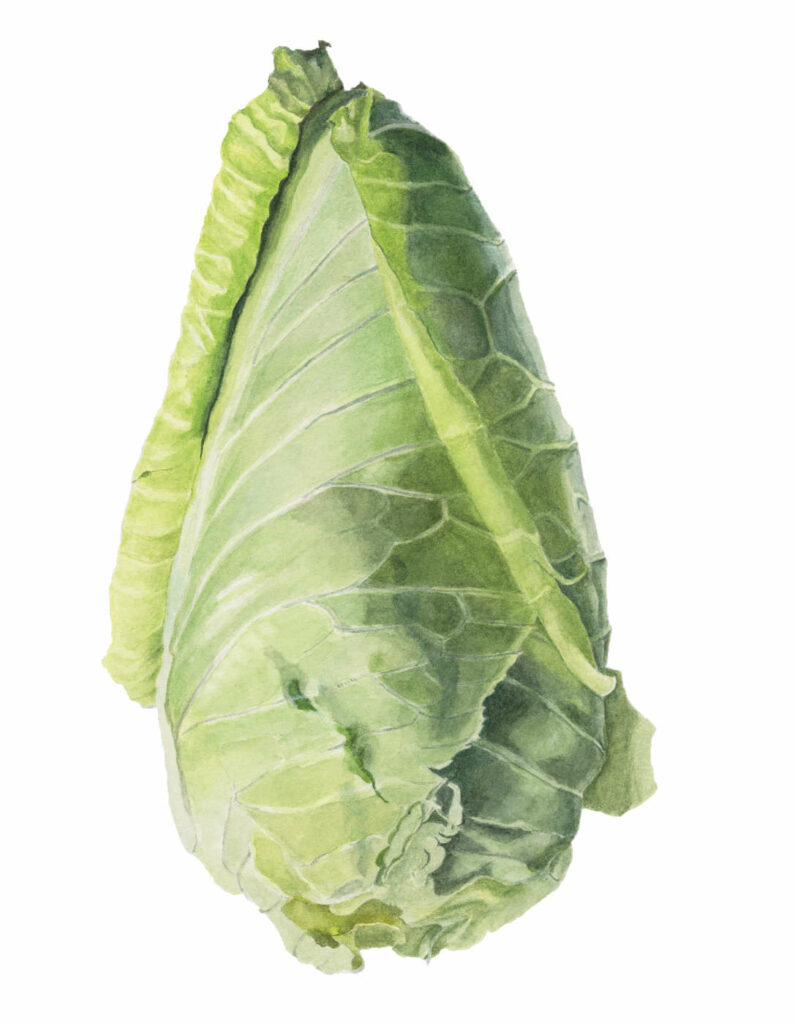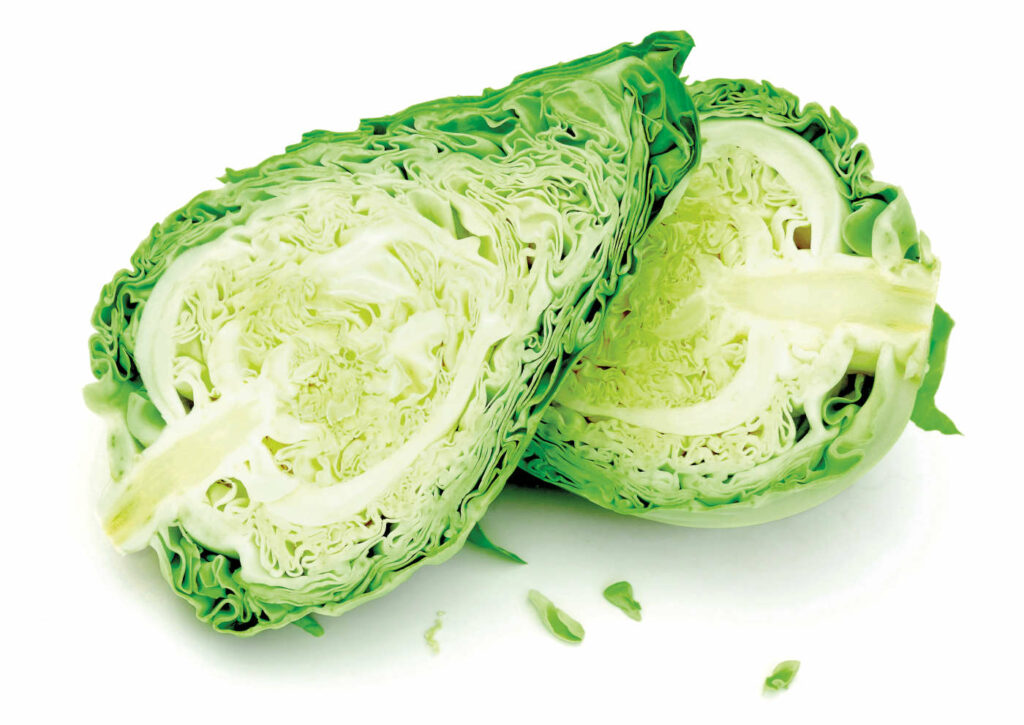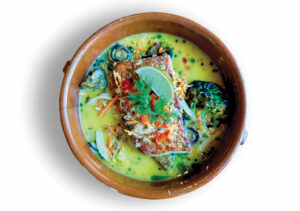
A chef’s secret comes to the farmers market
ILLUSTRATION BY SALLY JACOBS
Cabbage is one of the most versatile members of the brassica family, lending itself to both cooked and raw preparations. My all-time favorite variety to grow is a pointed heirloom known as arrowhead, cone or conehead, cabbage (Brassica oleracea).
You won’t find this specialty cabbage at a grocery store and it is even rarer to find it at the farmers market. Farmers who grow this interesting variety do it for the chefs and for food lovers who are interested in the flavor profile and uniqueness of this cabbage.
Arrowhead cabbage is a sweet and tender variety. The leaves make wonderful wraps and can be used in place of bread or tortillas. This variety lends itself to producing smaller heads if you plant them close together, and people often prefer a personal-size cabbage over a giant one.
Cone cabbages are an old heirloom variety, cultivated before cabbages were bred to be round and easier to mechanically process into kraut and coleslaw. And they are more flavorful than modern varieties bred for uniformity, long storage and high yields. Slow Food Foundation for Biodiversity lists the pointy cabbage on its Ark of Taste list as Filderkraut, also known as Filder—a generic name for pointed cabbage and the name of the area in Germany where the pointy cabbage originally grew and thrived.
Historical records from 1772 show that monks grew them at Denkendorf Monastery, indicating: “The white pointed cabbage is the only one which is grown in this area. What makes it particularly appreciated is the delicate softness of its leaves, its white color and in particular a whole better taste that makes it very different from other types grown in the nearby areas.”
Obdiel Luna, executive chef at La Bicyclette in Carmel, says he had never seen a pointy variety of cabbage before finding it at my farmers market stall.
“The interesting cone shape got my attention, so I bought some to try and found it very buttery and impressive,” says Luna. He likes to sear the pointed segments and place them under a piece of halibut in French curry. (See recipe below)
Arrowhead cabbage lends itself to raw applications like my favorite slaw—shredded with fresh mango slices, thinly sliced fennel and a dressing of Meyer lemon-infused mayonnaise with a bit of honey. For cooked use, I like to steam it with pot stickers and finish it with a drizzle of coconut amino acids, a splash of sesame oil and a bit of chili paste.
Joe Schirmer of Dirty Girl Produce in Watsonville likes how the texture of arrowhead cabbage is more “lettuce-y” than tough like regular head cabbage can be. He appreciates while it is the most tender cabbage, it still stores well and retains its soft texture. Schirmer plants arrowhead cabbage near his lettuces so they get more water than cabbage typically does, and spaces them close together to encourage smaller heads. Even when small, arrowheads retain their juicy, mild and sweet flavor.
Pointy cabbage, and cabbage in general, has a great texture that can be chewy and holds onto sauce in dishes. A quick go-to cabbage dish shared by a friend is delicious; simply sauté sliced cabbage in a little olive oil, salt and fresh dill. Add a maple syrup drizzle at the end.
Brad Briske from Home restaurant likes to make what he calls “Chicory Chee,” by combining radicchio with cabbage and a salt mix and allowing it to ferment at room temperature for a few weeks. The result is delicious and packs a healthy gut punch due to the bitter compounds in the radicchio and the fermentation process.
Cabbages are naturally high in fiber and an excellent source of calcium, magnesium and potassium. Of all the brassicas, cabbage contains the highest amounts of powerful antioxidants like glucosinolates, which protect against cancer. Besides containing many other important vitamins and minerals, what is most impressive is that one cup of cabbage contains 85% of the daily recommended vitamin K and 54% of the body’s need for vitamin C—more than an orange!
Cone cabbages are an old heirloom variety, cultivated before cabbages were bred to be round and easier to mechanically process into kraut and coleslaw.

GROWING AND STORING
Cone cabbage is a great addition to the garden, which includes many health benefits. It grows best in areas where temperatures are between 60° and 65°, but they can handle much colder weather, down to 20°. It is best to start cabbage from seedlings about 45 days before the outdoor planting date. Prepare your soil by loosening it well and adding some compost. If you have heavy clay or very sandy soils, cabbage won’t be happy. Plant seedlings 6 to 8 inches apart for small cone cabbage heads, or up to 12 inches for large heads. Cone cabbage will grow enormous if given the space and time. Blossom’s Farm has grown some very impressive coneheads that were 2 feet in length and weighed about 10 pounds each.
Floating row covers can help with pest issues like flea beetles and cabbage loopers. Be sure to rotate crop families in your garden to deter pests and fungal diseases, and water at the soil level instead of overhead to avoid mildew problems.
All cabbages are best stored whole in the refrigerator without a plastic bag until you are ready to use them. Remove the outer leaves if they look dry, or old and damaged. Cabbages can be continuously peeled back and will store famously in the refrigerator for months. The leaves underneath the outer ones will still be crisp and perfect.
When we have an abundance of a certain crop, I tend to play around with it and try all of the Instagram recipes that catch my eye. This one for roasted cabbage “steak” is worthy of trying and reporting on.
I sliced an arrowhead cabbage into half-inch slices and basted the slices with melted butter infused with garlic and thyme. Next, I roasted the pieces at 375° F until they were crisp and tender. Then I added chopped pistachios (walnuts or toasted pine nuts would work well too), Parmesan, arugula and lemon zest to the top of the cooked cabbage steaks. Served hot, this was a really brilliant way to enjoy cone cabbage! I could see this dish being inspired by various cuisines and the toppings be changed to reflect that, for instance roasting the cabbage with a miso, ginger, sesame oil and dashi coating, and topping with some panko crumbs and seared fish chunks. Or an Italian-inspired olive oil blend with sundried tomatoes and oregano, topped with some finely chopped sausage and Parmesan. You get the idea—cabbage can be an amazingly healthy vehicle for tasty toppings.

About the author
Jamie Collins is the owner of Serendipity Farms and has been growing organic row crops at the mouth of Carmel Valley since 2001. She distributes her produce through a CSA, u-picks and farmers’ markets.
- Jamie Collinshttps://www.ediblemontereybay.com/author/jcollins/
- Jamie Collinshttps://www.ediblemontereybay.com/author/jcollins/
- Jamie Collinshttps://www.ediblemontereybay.com/author/jcollins/
- Jamie Collinshttps://www.ediblemontereybay.com/author/jcollins/



